dashboard Acura CL 2002 Owner's Manual
[x] Cancel search | Manufacturer: ACURA, Model Year: 2002, Model line: CL, Model: Acura CL 2002Pages: 335
Page 1 of 335

2002 CL Online Reference Owner's Manual Use these links (and links throughout this manual) to navigate through this reference.
For a printed owner's manual, click on authorized manuals or go to www.helminc.com.
Contents
Owner's Identification Form
Introduction........................................................................\
............................................................................. i
A Few Words About Safety ........................................................................\
.................................................. ii
Your Car at a Glance ........................................................................\
.............................................................. 2
Driver and Passenger Safety ........................................................................\
............................................... 5
Proper use and care of your car's seat belts, and Supplemental Restraint System.
Instruments and Controls ........................................................................\
................................................... 51
Instrument panel indicator and gauge, and how to use dashboard and steering column controls.
Comfort and Convenience Features ........................................................................\
............................... 113
How to operate the climate control system, the audio system, and other convenience features.
Before Driving ........................................................................\
..................................................................... 161
What gasoline to use, how to break-in your new car, and how to load luggage and other cargo.
Driving ........................................................................\
................................................................................... 175
The proper way to start the engine, shift the tr ansmission, and park, plus towing a trailer.
Maintenance ........................................................................\
......................................................................... 205
The Maintenance Schedule shows you when you need to take your car to the dealer.
Appearance Care ........................................................................\
................................................................. 265
Tips on cleaning and protecting your car. Things to look for if your car ever needs body repairs.
Taking Care of the Unexpected ........................................................................\
....................................... 273
This section covers several problems motorists someti mes experience, and how to handle them.
Technical Information ........................................................................\
....................................................... 303
ID numbers, dimensions, capaciti es, and technical information.
Warranty and Customer Relations (U.S. and Canada)......................................................................317
A summary of the warranties covering yo ur new Acura, and how to contact us.
Authorized Manuals (U.S. only) ........................................................................\
....................................... 321
How to order manuals and other technical literature.
Index
Service Information Summary
A summary of information you need wh en you pull up to the fuel pump.
Page 13 of 335

Keeping your doors locked reduces
thechanceof beingthrownoutof
the car during a crash. It also helps
prevent occupants f rom accidentally
opening a door and f alling out, and
outsiders f rom unexpectedly opening
your doors. Head restraints can help protect you
f rom whiplash and other injuries. For
maximum protection, the back of
your head should rest against the
center of the head restraint.Move the f ront
seats as far back as possible, and
keep adjustable seat-backs in an
upright position whenever the car is
moving.
Your car’s seats are designed to keep
you in a comf ortable, upright
position so you can take f ull
advantage of the protection offered
by seat belts and the energy
absorbing materials in the seats.
How you adjust your seats and seat-
backs can also affect your safety. For
example, sitting too close to the
steering wheel or dashboard
increases the risk of you or your
passenger being injured by striking
theinsideof thecar,orbyan
inf lating airbag.
Reclining a seat-back too f ar reduces
the seat belt’s ef f ectiveness and
increases the chance that the seat’s
occupant will slide under the seat
belt in a crash and be seriously
injured.
To do their job, airbags must
inf late with tremendous f orce and
speed. So while airbags help save
lives, they can cause minor injuries,
or more serious or even fatal
injuries if occupants are not
properly restrained or sitting
properly.
Always wear
your seat belt properly, and sit
upright and as f ar back as possible
f rom the steering wheel or
dashboard.
Driver and Passenger Saf ety
Your Car’s Saf ety Features
Door L ocks Head Restraints
Seats & Seat-Backs
What you should do:
A irbags of f er no prot ect ion in rear
impact s, rollovers, or minorf ront al or side collisions.
Airbags can pose serious hazards.
What you should do:
10
Page 14 of 335

All adults, and children who have
outgrown child saf ety seats, are
wearing their seat belts and
wearingthemproperly(seepage).
Any inf ant or small child is
properly restrained in a child seat
inthebackseat(seepage ).
To make sure you and your
passengers get the maximum
protection f rom your car’s saf ety
f eatures, check the f ollowing each
time before you drive away:
The rest of this section gives more
detailed inf ormation about how you
can maximize your saf ety.
Remember, however, that no saf ety
system can prevent all injuries or
deaths that can occur in severe
crashes, even when seat belts are
properly worn and the airbags deploy.
Head restraints are properly
adjusted (see page ). Frontseatoccupantsaresitting
upright and as f ar back as possible
f rom the steering wheel and
dashboard (see page ).
All cargo is properly stored or
secured (see page ). Seat-backs are upright (see page
).
Both doors are closed and locked
(see page ).
15
20 13
14 15
12 171
Driver and Passenger Saf ety
Pre-Drive Saf ety Checklist
Your Car’s Saf ety Features
11
Page 17 of 335
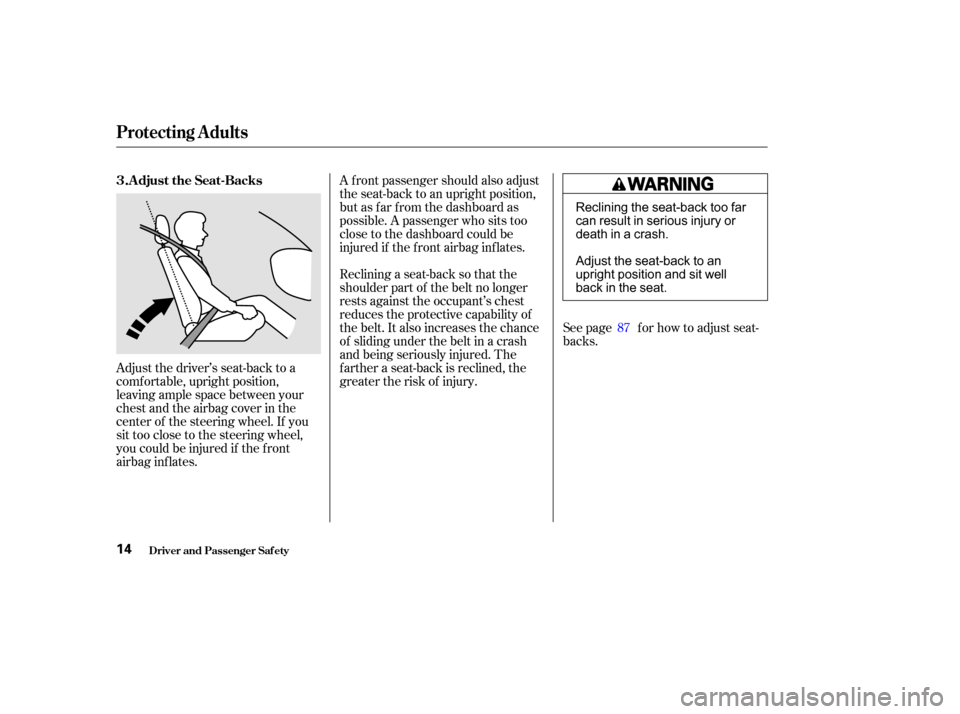
See page f or how to adjust seat-
backs.
A f ront passenger should also adjust
the seat-back to an upright position,
but as f ar f rom the dashboard as
possible. A passenger who sits too
close to the dashboard could be
injured if the f ront airbag inf lates.
Reclining a seat-back so that the
shoulder part of the belt no longer
rests against the occupant’s chest
reduces the protective capability of
the belt. It also increases the chance
of sliding under the belt in a crash
and being seriously injured. The
farther a seat-back is reclined, the
greater the risk of injury.
Adjust the driver’s seat-back to a
comf ortable, upright position,
leaving ample space between your
chest and the airbag cover in the
center of the steering wheel. If you
sit too close to the steering wheel,
you could be injured if the f ront
airbag inflates. 87
Driver and Passenger Saf ety
Protecting Adults
Adjust the Seat-Backs
3.
14
Reclining the seat-back too far
can result in serious injury or
death in a crash.
Adjust the seat-back to an
upright position and sit well
back in the seat.
Page 21 of 335
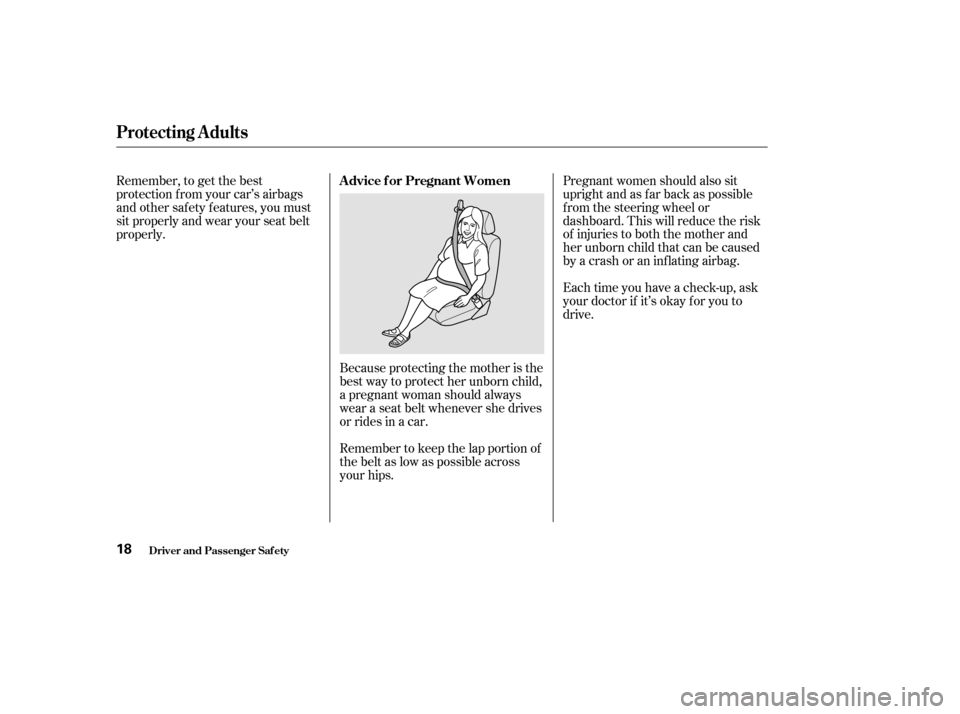
Because protecting the mother is the
best way to protect her unborn child,
a pregnant woman should always
wear a seat belt whenever she drives
or rides in a car.Pregnant women should also sit
upright and as f ar back as possible
f rom the steering wheel or
dashboard. This will reduce the risk
of injuries to both the mother and
her unborn child that can be caused
by a crash or an inf lating airbag.
Each time you have a check-up, ask
your doctor if it’s okay f or you to
drive.
Remember to keep the lap portion of
the belt as low as possible across
your hips.
Remember, to get the best
protection f rom your car’s airbags
and other safety features, you must
sit properly and wear your seat belt
properly.
Advice f or Pregnant Women
Protecting Adults
Driver and Passenger Saf ety18
Page 22 of 335

If they do, they
could be very seriously injured in a
crash. Carrying hard or sharp
objects on your lap, or driving with
a pipe or other sharp object in
your mouth, can result in injuries
if your f ront airbag inf lates.
If your
hands or arms are close to the
airbag cover in the center of the
steering wheel or on top of the
dashboard, they could be injured if
the f ront airbags inflate.
Any object
attached to or placed on the covers
marked ‘‘SRS AIRBAG’’ in the
center of the steering wheel and
on top of the dashboard could
interf ere with the proper operation
of the airbags. Or, if the airbags
inf late, the objects could be
propelled inside the car and hurt
someone.
Devices intended to improve
occupant comf ort or reposition the
shoulder part of a seat belt can
severely compromise the
protective capability of the seat
belt and increase the chance of
serious injury in a crash. If a side airbag
inflates,acupholderorotherhard
object attached on or near the
door could be propelled inside the
car and hurt someone.
Additional Saf ety Precautions
T wo people should never use t he
same seat belt . Do not place hard or sharp object s
bet ween yourself and a f rontairbag.
K eep your hands and arms awayf rom t he airbag covers.
Do not at t ach or place object s on
the f ront airbag covers.
Do not put any accessories on seat
belts. Do not at t ach hard object s on or
near a door.
Protecting Adults
Driver and Passenger Saf ety19
Page 25 of 335
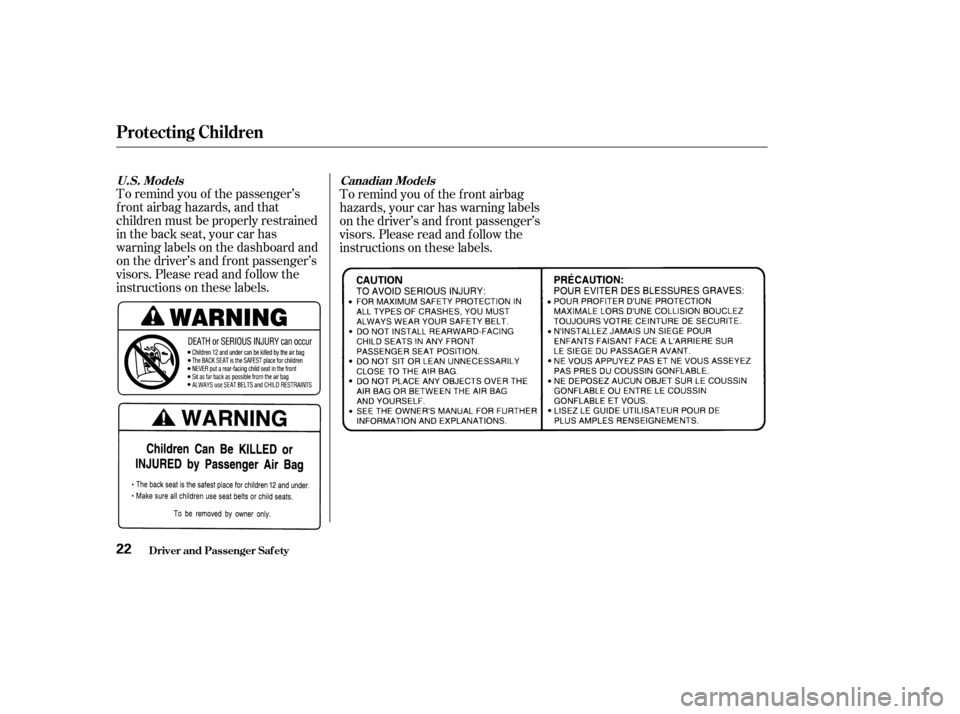
To remind you of the passenger’s
f ront airbag hazards, and that
children must be properly restrained
in the back seat, your car has
warninglabelsonthedashboardand
on the driver’s and f ront passenger’s
visors. Please read and f ollow the
instructions on these labels.To remind you of the f ront airbag
hazards, your car has warning labels
on the driver’s and f ront passenger’s
visors. Please read and f ollow the
instructions on these labels.
U.S. Models
Canadian Models
Protecting Children
Driver and Passenger Saf ety22
Page 34 of 335
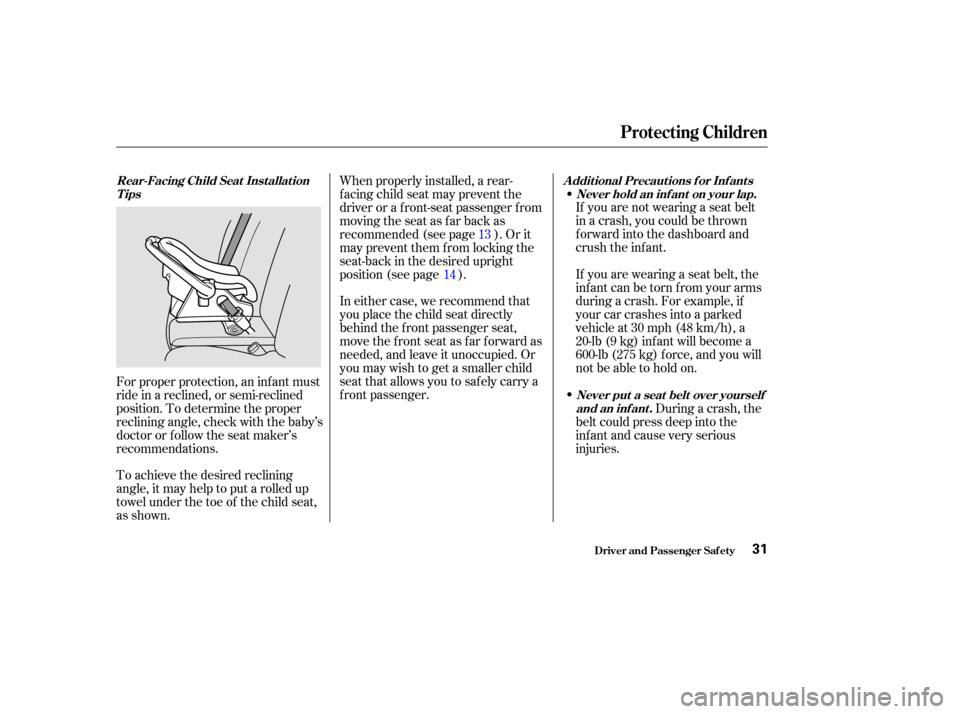
If you are not wearing a seat belt
in a crash, you could be thrown
f orward into the dashboard and
crush the inf ant.
If youarewearingaseatbelt,the
infantcanbetornfromyourarms
during a crash. For example, if
your car crashes into a parked
vehicleat30mph(48km/h),a
20-lb (9 kg) inf ant will become a
600-lb (275 kg) f orce, and you will
not be able to hold on.
In either case, we recommend that
you place the child seat directly
behind the f ront passenger seat,
move the front seat as far forward as
needed, and leave it unoccupied. Or
you may wish to get a smaller child
seat that allows you to safely carry a
f ront passenger. When properly installed, a rear-
f acing child seat may prevent the
driver or a f ront-seat passenger f rom
moving the seat as far back as
recommended (see page ). Or it
may prevent them f rom locking the
seat-back in the desired upright
position (see page ).
To achieve the desired reclining
angle, it may help to put a rolled up
towel under the toe of the child seat,
as shown. Forproperprotection,aninfantmust
ride in a reclined, or semi-reclined
position. To determine the proper
reclining angle, check with the baby’s
doctor or f ollow the seat maker’s
recommendations. During a crash, the
belt could press deep into the
infant and cause very serious
injuries.
13
14
A ddit ional Precaut ions f or Inf ant s Never hold an inf ant on your lap.
Rear-Facing Child Seat Inst allat ion
Tips
Never put a seat belt over yourselfand an inf ant.
Protecting Children
Driver and Passenger Saf ety31
Page 38 of 335

When a child reaches the
recommended weight or height limit
for a forward-facing child seat, the
child should sit in the back seat and
wear a lap/shoulder belt.
If you are not wearing a seat
belt in a crash, you could be
thrown f orward into the
dashboard and crush the child.
During a crash, the
belt could press deep into the child
and cause very serious injuries. If youarewearingaseatbelt,the
child can be torn f rom your arms
during a crash. For example, if
your car crashes into a parked
vehicleat30mph(48km/h),a
30-lb (14 kg) child will become a
900-lb (410 kg) f orce, and you will
not be able to hold on. If a child is too short f or the shoulder
part of the belt to properly f it, we
recommend that the child use a
booster seat until the child is tall
enough to use the seat belt without a
booster.
The f ollowing pages give
instructions on how to check proper
seat belt f it, what kind of booster
seat to use if one is needed, and
important precautions f or a child
who must sit in the f ront seat.
CONT INUED
Protecting L arger ChildrenA ddit ional Precaut ions f or Small
Children Never hold a small child on yourlap.
Never put a seat belt over yourselfand a child.
Protecting Children
Driver and Passenger Saf ety35
Allowing a larger child to sit
improperly in the front seat can
result in injury or death if the
passenger’s front airbag inflates.
If a larger child must sit in front,
make sure the child moves the
seat as far back as possible
and wears the seat belt properly.
Page 46 of 335
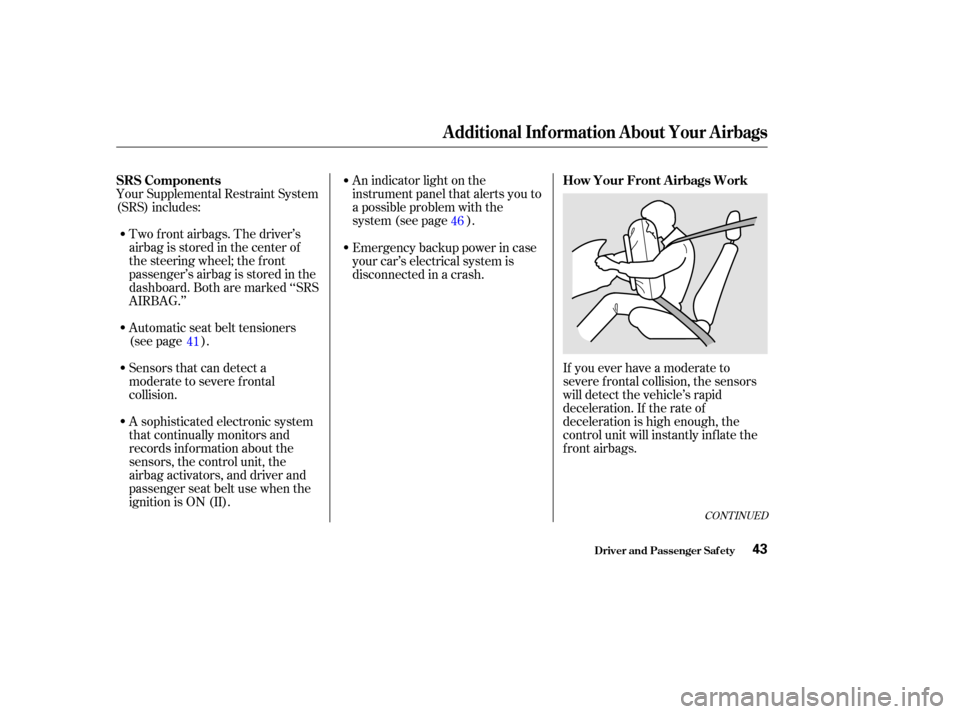
Your Supplemental Restraint System
(SRS) includes:An indicator light on the
instrument panel that alerts you to
a possible problem with the
system (see page ).
Two f ront airbags. The driver’s
airbag is stored in the center of
the steering wheel; the f ront
passenger’sairbagisstoredinthe
dashboard. Both are marked ‘‘SRS
AIRBAG.’’
Sensors that can detect a
moderate to severe frontal
collision. Automatic seat belt tensioners
(see page ). Emergency backup power in case
your car’s electrical system is
disconnected in a crash.
If you ever have a moderate to
severe f rontal collision, the sensors
will detect the vehicle’s rapid
deceleration. If the rate of
deceleration is high enough, the
control unit will instantly inf late the
f ront airbags.
A sophisticated electronic system
that continually monitors and
records inf ormation about the
sensors, the control unit, the
airbag activators, and driver and
passenger seat belt use when the
ignition is ON (II). 41
46
CONT INUED
SRS Components
How Your Front A irbags Work
Driver and Passenger Saf ety
Additional Inf ormation About Your Airbags
43